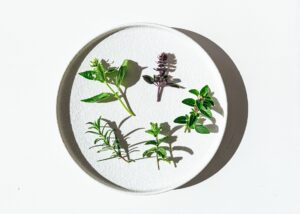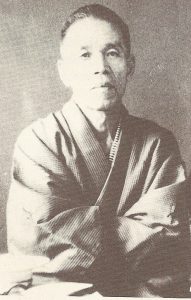Wabi-sabi is an aesthetic concept that is very closely related to Zen Buddhism. It refers to the ability to see beauty with the heart. This Asian philosophy can help humble people lead happier and more fulfilling lives. The term Wabi-Sabi was introduced in the 16th century by the Japanese tea master and Zen monk Sen no Rikyū. The corresponding way of thinking was already widespread throughout the entire Japanese Middle Ages (i.e. from around the 12th century). Even in Japanese antiquity (7th to 11th centuries) there are already some approaches in this direction, but these had to take a back seat to other ideals. There are certain words and expressions in the Japanese language that accurately reflect the consciousness and philosophy of the Japanese, one of which is Wabi-Sabi. This expression is derived from the Japanese tea custom called “Daidao” (the way of tea, also called Cha-do) or the custom of preparing and serving tea. This expression clearly shows the aesthetic awareness, or the appreciation of beautiful things , the Japanese. Like the words “young” (deep affection).
Wabi Sabi 寂 侘
“Wabi” originally means: to feel lonely and lost. This turned into the joy of the astringency of the lonely-quiet. Please do not confuse this with psychological suffering. Wabi-Sabi does not have to – and should not – be treated. Wabi Sabi is above all a question of attitude. But it was only in connection with “Sabi”: being old, showing patina, having maturity that the actually untranslatable term unit emerged, which forms the standard of Japanese art evaluation. The highest is not the obvious beauty, but the veiled, not the immediate shine of the sun, but the broken of the moon. The moss-covered rock, the thatched roof overgrown with grass, the gnarled pine, the slightly rusted tea kettle, that and the like are the symbols of this ideal of beauty. It is about the majesty that is hidden in the shell of the inconspicuous, the austere simplicity that reveals all the charms of the beautiful to the understanding.
What is the principle of Sabi and Wabi?
The term cannot be precisely described. It includes the terms old, venerable, antique, ripe, steamed, with patina. … Wabi-Sabi also describes the feeling when looking at the transience of things that are beautiful precisely because of this transience, the beauty of a suiseki or a bonsai, for example, which have aged over many years. Sabi and Wabi together create an attitude of calm and serenity in us. The term stands as a subjective feeling for an image of a lonely fisherman’s hut on the beach, whipped by the storm, on a gray winter day. A vague, mood steeped in the enjoyment of the magic of the simplest of things. Wabi gives us a feeling for the simplicity and naturalness of things. A pair of old wooden shoes like the one in the following picture – that’s Wabi Sabi.

On the other hand … Repairing such “old-fashioned” shoes with modern technology has nothing to do with Wabi-Sabi.
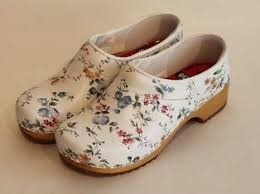
The origins of Wabi-Sabi
Sabi and Wabi is a concept of aesthetics that is very closely related to Japan and Zen Buddhism. It’s a way of feeling things with the heart. Sabi and Wabi directs the gaze to the process of becoming and passing away in everything and finds inner beauty in – on the surface – seemingly unfinished, imperfect, ephemeral. The patina on copper temple roofs, laugh lines in the weathered face of a rice farmer, the wrinkled beauty of an umeboshi – the wrinkled umeboshi even meets the highest standards of Wabi-Sabi – a conscious slowing down in the pace of life … that is all Sabi and Wabi.
In the sixteenth century, the Japanese tea master and Zen monk Sen no Rikyu introduced the term Wabi Sabi. The following little anecdote is known about him: “Sen no Rikyu wanted to learn the way of tea, so he went to the tea master Takeno Joo. Joo ordered Rikyu to clean up the garden, and Rikyu immediately got to work. He right the garden until the soil was in perfect order. When he was done, he looked at his work. Then he shook the cherry tree so that a few blossoms fell randomly to the ground. The tea master Joo took Rikyu into his school.” Originally, “wabi” meant feeling miserable, lonely and lost. This turned into the joy of the astringency of solitary silence. Please do not confuse this with psychological suffering.
Wabi-Sabi does not have to – and should not – be treated. But it was only in connection with “Sabi”: being old, showing patina, having maturity that the actually untranslatable term unit emerged, which forms the standard of Japanese art evaluation.
Wabi Sabi in the Japanese arts
Many Japanese art movements in the last 1,000 years have been influenced by Zen, especially by the acceptance and contemplation of the imperfection, the constant flow and the impermanence of all things. Such arts can exemplify the aesthetics of Wabi-Sabi. These include, for example:
- Shinsendô
- OnmYodô, InYodô – the way of Yin and Yang – InYologie
- Shokuyodô – The way of nutrition “Macrobiotics” (Shojin-Ryori).
- Japanese gardens
- bonsai
- Kadô, (Ikebana, Moribana) – Literally, living flowers. The art of arranging flowers. The meditative form of Ikebana is the Kadô.
- Sadô, Chadô Japanese tea ceremony
- Honkyoku (traditional shakuhachi music of the wandering Zen monks)
- Haikudô or Shikisima no michi – the art of poetry, poetry
- Karatedô, Aikidô, Kyudô, Iaidô
And many more. I have listed all the “Dô” – way arts in the book: InYologie – the detailed teaching of Yin and Yang and explained them in detail. https://vivoterra-world.com/shop/inyologie-die-detaillierte-lehre-von-yin-und-yang/
My criticism of the modern Wabi Sabi interpretation
- Kintsukuroi: “Imperfection makes an object more resistant and more beautiful …”
This title alone manipulates the content in the direction of a false doctrine, if the content is written to match the title. The term “imperfection” means “imperfect” – what Wabi and Sabi Not are, “unfinished” – what Wabi and Sabi Not are, “unwanted” – what Wabi and Sabi Not are, “unwanted” discrepancies in technology – what Wabi and Sabi Not are,
- Kintsukuroi: “makes an object more resistant …” what Wabi and Sabi Not power and wabi and sabi Not properly defined.
I do not question the terms “kintsukuroi” and “imperfection”. I say: these terms belong Not to Sabi and Wabi because they would teach Sabi and Wabi wrong. Kintskuroi is a noble, Japanese repair technique, but has Sabi and Wabi Nothing to do!

Anyone who interprets the Wabi-Sabi principle in this way and thinks that he can do Wabi-Sabi according to the JEKAMI principle. Transferred to any area, the Wabi-Sabi principle has not understood sufficiently. Wabi-sabi has nothing to do with imperfection. On the contrary, wabi-sabi is perfect in itself. Only those who do not understand the principle of Sabi and Wabi sufficiently will interpret Sabi and Wabi as “unsightly”, “imperfect”, “in need of repair”.
This is exactly how the ignorant try to “psychiatize” Wabi-Sabi. Wabi-Sabi also suggests this in the wrong direction. Because Wabi-Sabi does not have to, and should not, be treated. Naturally created wabi-sabi must not be artificially “beautified”; a naturally crooked jaw does not have to, and should not, be artificially straightened and “repaired”, because this does not “improve” sabi and wabi, but “worsens” and destroys it . A worn car tire that is re-rubberized – no matter how technically perfect it is done – has nothing to do with the principle of Wabi-Sabi. This is just a perfect repair.
If objects are broken and are being repaired – no matter how technically perfect these repairs are, it has nothing to do with Wabi-Sabi. If an old person has wrinkles of life in his skin – which is also what Wabi-Sabi has – these wrinkles do not need to be treated or repaired. Because the “repaired” face would also destroy Wabi-Sabi.

And here is an example of modern “Kintskuroi” – a face that was lifted with surgical technology – what no Wabi Sabi is.

It is completely different when objects are “worn out” through use and therebyShow traces of “old” and “used”, these objects can follow the principle of Wabi-Sabi correspond . For example, if a farmer uses a wooden shovel for years to transfer grain from the storehouse into containers, this wooden shovel wears out over the years and receives “signs of use. This is sabi and wabi. Or in the past, when ordinary people used the same – their own – eating utensils all their lives, these eating spoons showed signs of wear and use, but were left as they were and continued to be valued without repairing them. This is wabi-sabi. No farmer would think of repairing these “marks of wear and tear”. That is wabi-sabi attitude and wabi-sabi appreciation.
Wabi-Sabi in architecture – Feng-Shui
Wabi-Sabi for artists, architects and designers. Japan’s philosophy of humility. Wabi-Sabi is the most striking and characteristic expression of what we consider traditional Japanese beauty. In the Japanese pantheon of aesthetic values like the Greek ideals of beauty and perfection in the West. In its most comprehensive form, Wabi-Sabi can be a form of lifestyle; at its most narrow, it is a certain kind of beauty. At first glance, Wabi-Sabi objects appear simple, artless, a bit rural and rough in their surface structure. Wabi-Sabi has some traits in common with what we usually call “primitive art”, ie with objects that are crude, simple, undemanding and made of natural materials. Wabi Sabi in architecture

Repairing such “old-fashioned” houses with modern technology – that has nothing to do with Wabi Sabi.

Wabi-sabi becomes never used . Wabi-sabi arises always in a natural way . Originally, the Japanese words Wabi and Sabi had very different meanings. Sabi actually meant “shivering”, “emaciated” or “withered”. It is also important to know – with every translation also from Japanese into German – translation or interpretation errors can occur.
A translation (teaching) is only as good as the translator’s understanding. The self-imposed isolation and voluntary poverty of the hermit and ascetic were seen as ways of attaining spiritual wealth. For lovers of poetry, this way of life encouraged openness to the small details of everyday life and deeper insight into the beauty of the inconspicuous and easily overlooked aspects of nature. On the other hand, a simplicity, which at first glance seems unappealing, acquired its own meaning as the basis of a new, pure form of beauty.
If one wants to consider Wabi and Sabi as “separate” phenomena (antagonisms), one would characterize their differences as follows:
| Wabi represents | Sabi represents |
|
|
But if you understand the principle of Sabi and Wabi sufficiently, you will not want to separate these two terms. A path master does not separate yin from yang either – that would be dualism – and still knows the differences very well.
Wabi-sabi in martial arts
Another excellent example of wabi-sabi is the obi, the belt of an experienced karate master. I’ve had my kuroi obi (black belt) since 1999 and I usually wear it a few times a week. Apart from the normal wear and tear of every piece of clothing, it is dragged over the ground and grass during the ukemi, and tortured during beach training (on the beach by the sea) … After many years the obi is scuffed – also by tying countless knots. The fabric is worn around the part that will be knotted. You can see the white fibers inside. You wear an old obi until the time is right to change it. This can be at graduation or as a gift.
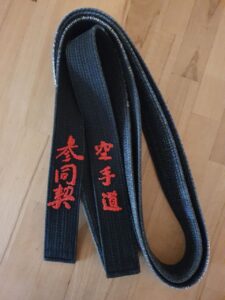
Wabi-Sabi in martial arts can also be seen when wearing the karate-aikido-judo-gi (suit). In the traditional fighting coasts one embroidered e.g. his karate suit doesn’t have a logo. It remains simple, pure and white. Another area is in zazen (sitting zen). When an experienced karate teacher (sensei) sits down to meditate, he will turn his obi with the embroidered side on which usually the name of the school or style is embroidered – not outwardly visible for all, but according to the principle of Wabi-Sabi – in Gratitude and humility modestly turn the unembroidered side of the belt outwards. That is the Sabi-Wabi principle of humility.
Wabi-Sabi in the art of drinking tea – Cha-do
Against the background of the more widespread Zen Buddhism, a new aesthetic principle developed in Japan in the 16th century at the instigation of some tea masters, despite the resistance of the wealthy class, who practiced the tea ceremony as a tradition to show off glamor and luxury – Wabi Sabi. The Japanese Wabi-Sabi aesthetic ranges from a metaphysical basis to spiritual values, moral regulations, to material quality, which is also expressed in the art of tea and has an impact on many areas of art and culture. Simplicity and appreciation are at the center of this outlook. “The young Zen monk Sen noRikyu wanted to learn Cha-Dō, the way of tea. Therefore, he sought out the famous tea master TakenoJōō. Master ordered Rikyu to clean up the garden, and he immediately got to work. He swept and righted until the floor was in perfect order. When he finished, Rikyu paused and looked at his work. Then he shook the cherry tree so that a few petals fell randomly to the ground. When tea master Jōō saw this, he took Rikyu into his school. “
Wabi-Sabi in macrobiotics – Shokuyo-do
Wabi-Sabi using the example of an Umeboshi: The Japanese Ume tree starts to flower at the end of February, until the beginning of March, before the cherry blossoms. Often snow still covers the ground. The hidden life force of the delicate-looking, elegant white flowers was a preferred object in Far Eastern paintings and poems. The flowers then produce the fruits that get big and bigger. Towards the end of May, the green fruits are collected just before they turn slightly yellow. Several thousand fruits can be gathered from one tree. At this time, the plums taste extremely sour.
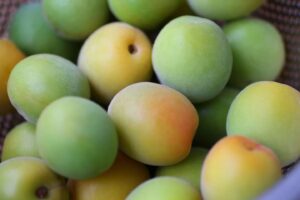
The freshly picked plums are first washed and then dried on rice mats by exposing them to sunlight. The plums are also left outside during the night. Then dew forms and softens the plums. The next day the sunshine dries them again and at night the dew makes them soft again. This process is repeated for several days. As a result, the plums get smaller and smaller and develop a lot of wrinkles. That is wabi-sabi. After this phase, the plums are poured into barrels together with white coarse sea salt and covered with a weight. The salt and pressure cause the plums to shrivel and their juice to collect in the bottom of the container.
Since the plums were dried well, this juice will not cover the plum filling. When filling the barrels, purple leaves of buffalo grass, so-called shiso leaves, are added to the plums. Freshly picked leaves are first rubbed and rolled by hand to break up the plant’s cell structure. In this way, once they have been mixed with the plums in the barrel, their color is quickly released to give them a deep red color. This colouring is responsible for the colour of the umeboshi, and it also contributes to the special taste of the umeboshi.After the plums, salt and shiso are in the barrel, and the weight is put on, the barrel is covered and left to stand for at least six months. Umeboshi can be cured for much longer, however, and they actually get better over time. Umeboshi that are six or seven years old are of great value. The originally crunchy fruits, with a smooth surface, become soft and “wrinkled” after the fermentation process.

According to the modern “beauty ideal”, these fruits are no longer beautiful. According to the principle of Wabi-Sabi, however, these “old” Umeboshi – which have been battered for several years – even meet the highest standards of Sabi and Wabi.
Wabi-Sabi in the art of flower arrangement – Ikebana
Ikebana – literally “living flowers” – is the Japanese art of arranging flowers. The meditative form of Ikebana is called Kadō – “Path of Flowers”. Both students and teachers of the Kadō are called Kadōka. Ikebana belongs to the group of gentle do – the gentle arts. While flower arrangements in the west often look like this and the flower vases are completely filled

… flower arrangements look like this according to Ikebana rules:
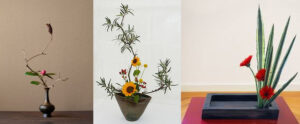
The three levels symbolize “Earth – Man – Heaven”. And “empty” space is not only accepted, it is even wanted. This is wabi-sabi in the art of flower arrangement.
Wabi Sabi in the Art of Poetry
The principle of Wabi Sabi is shown in the essence of poetry, Haikudô (Shikisima no michi) 俳 句
The essence of poetry:
Literally translated, haiku in Japanese means something like “funny verse”, although the verses are actually rarely funny, but rather reminiscent of Zen wisdom. One of the most important Japanese haiku poets was Matsuo Basho (1644–1694).
The famous frog haiku comes from him:
古 池 や
蛙 飛 び 込 む
水 の 音
furu ike ya
kawazu tobikomu
mizu no oto
The old pond:
A frog jumps into it.
Oh! The sound of the water.
Another example of Wabi-Sabi can be found in the art of Zen painting. The pictures are painted with as few brushstrokes as is necessary to often show the picture only vaguely. And yet you can clearly see what the picture is trying to show. Unique and unmistakable.
Wabi-Sabi and the teaching of Way Masters
The word ‘wabi’ means the ability to find true contentment of the heart in the midst of poverty and want. Sabi “means the ability to gain a deep understanding from the simplest of conditions. Both show the psyche of the Japanese people, the ability to take heart and gain deep understanding under all conditions. The origin of this expression, “Wabi Sabi”, has an interesting history.
During his youth, Sen No Rikyu, the 15th century Japanese master of the tea ceremony, sought advice from a famous teacher. This teacher decided to test Rikyu to see what kind of person he was before teaching him the art of daidao. So this teacher instructed Rikyu to tend the garden. Rikyu pulled weeds, raked the ground, planted beautiful plants and trees, and created an almost perfect garden. In an aesthetic sense, it was a garden that lacked nothing.
But Sen No Rikyu found that something was wrong with his garden just before he wanted to show it to his teacher. He discovered that his garden looked too man-made, that it looked too man-made, and that it didn’t contain enough of the natural beauty of nature. Sen No Rikyu then grabbed one of the cherry trees and shook it until its blossoms covered the perfectly laid out garden soil. He felt that this would make his garden more beautiful. The ability to look at life and nature in a new, special way, as Sen No Rikyu did, is known as “Wabi-Sabi”.
Aestheticism, or the standard of beauty, of the 15th century in Japan was characterized by the appreciation of ornate ornamentation and absolute perfection. Sen No Rikyu tried to rediscover the appreciation of simple, natural beauty through imperfection, and this movement was later referred to as “Wabi-Sabi”.
The way of Wabi Sabi
There are many ways. The path of enlightenment through the teachings of the Buddha (Zen-do), the path of medicine (I-do), the path of drinking tea (Cha-do), the path of martial arts (Budo), and many more. All paths have the same essence, follow the same universal laws and lead to the same goal. Our attitude here and now affects the whole universe. Our behavior will reflect back on our daily life. Have faith in the forces and the order of the universe. Do not disturb them arbitrarily, but let them guide you and live in harmony with them. Live the principle of SABI and WABI.
Wabi-Sabi “Beauty” explained with the concept of Yin and Yang
Illustration: Wabi Sabi Principle of Beauty The four Japanese words for “beauty” can be explained with the concept of Yin and Yang:
- Hade = colorful, boldly patterned, bubbly in the overall picture, is Yang and is considered an immature, youthful aesthetic style.
- Jimi = the opposite of Hade, is sober and set in color, neatly correct and therefore lackluster. There is nothing “showing off” there, not an essential characteristic. That is considered yin.
- Iki = lies between the two above types of beauty. Iki corresponds to the French word “chic”, smart, stylish, elegant, fashionable, clever and sophisticated. Iki is more yin than Hade, but more yang than Jimi.
- Shibui = unparalleled beauty. It is absolute, outside of yin and yang.
More on this in the book: InYology – the detailed teaching of Yin and Yang, on over 900 pages. https://vivoterra-world.com/shop/inyologie-die-detaillierte-lehre-von-yin-und-yang/
Let us learn to see beauty with our hearts again in order to be able to enjoy life in harmony with nature.



